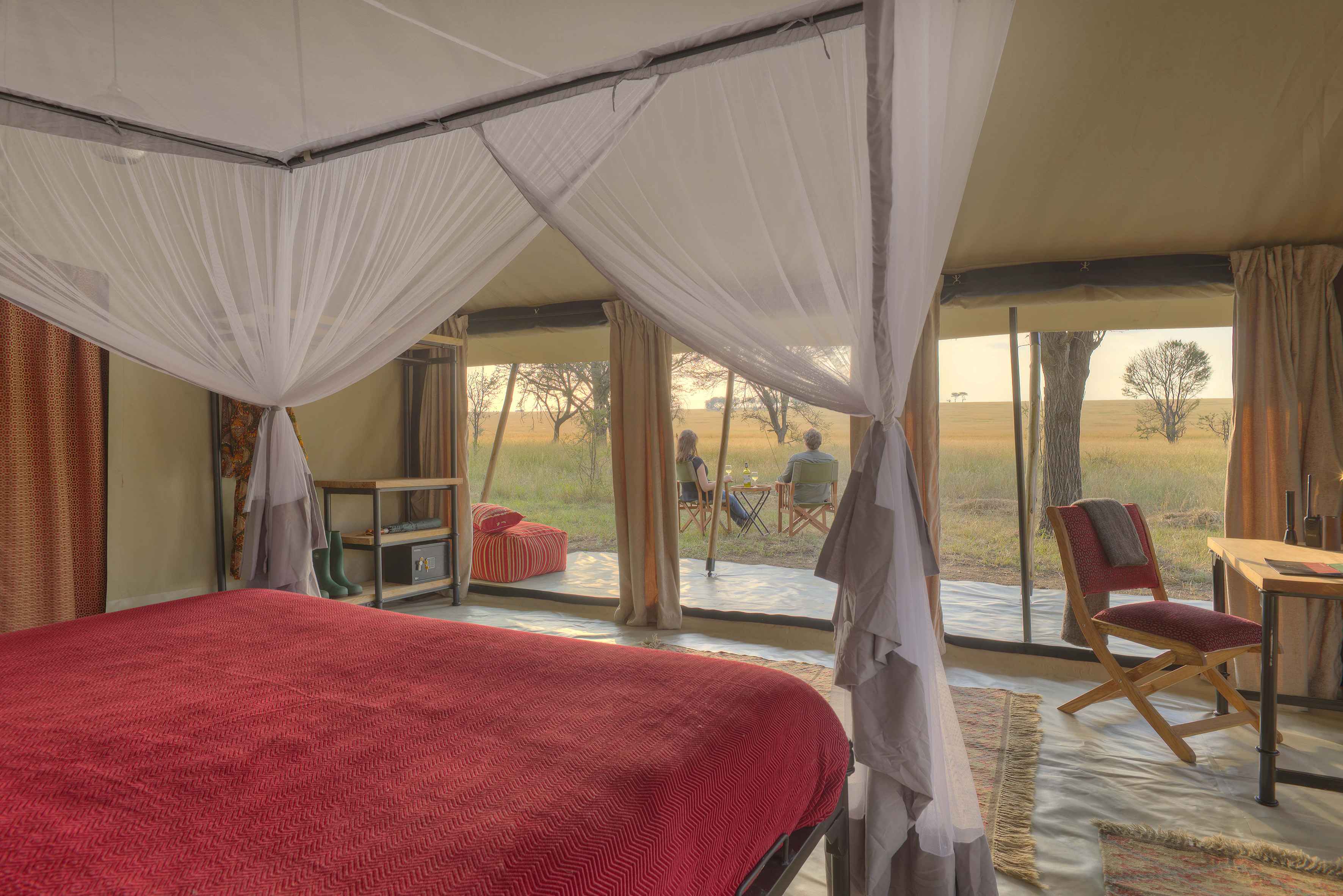Kimondo is a mesmerizing mobile safari camp that tracks the seasonal Great Wildebeest Migration from the dramatic Lamai Wedge and Mara River in winter to the lush southern Serengeti grasslands in the height of summer. Handcrafted from wood and canvas in an exotic blend of traditional East African safari style with a subtle Moroccan influence, Kimondo Migration Camp has just nine elegant and airy tents, each with a king-sized cast-iron bed, en-suite bathroom and private veranda. This mobile safari camp offers a truly intimate Big Five adventure in vintage East African style and comfort.
Kimondo Migration Camp pays tribute to an age when merchants from North Africa crossed the Serengeti on camelback to trade goods and spices along the East Coast. The mobile camp constructed of wood and canvas reflects traditional safari style with a Moroccan accent – simple, elegant, and entirely at home in this unspoiled landscape. Rich, handwoven rugs line the floors in the dining tent, where burnished copper lanterns glow into the night. Dinner is served either under canvas or the African night sky. Afterwards, trade stories of the day’s sightings besides the crackling campfire.
* The Migration Camp explores the Lamai region in the North (Jul-Nov) / Camp shifts to Serengeti South (Dec-Mar).
Guest Tents
The nine traditional tents at Kimondo are an exercise in spacious and elegant safari style. Each tented suite is furnished with cast-iron king-sized beds (twins available) that rest under the canvas ceilings. The private en-suite bathroom features safari bucket shower, hot and cold running water and flushing toilet. Private verandas are furnished with a comfortable chaise lounge – the perfect place for a siesta during the long, lazy afternoons.
The activities availble at Kimondo Migration Camp vary depending on where the camp is located for the season.
December- March Activities
Game Drives
Wildlife viewing and bird watching game drives are offered twice per day. Experienced guides encourage guests to see and experience the Serengeti through their eyes, sharing a world of small and large wonders that only they truly know and understand. Guests can arrange full days in the bush with picnic lunches or shorter excursions returning to enjoy the tranquility of camp.

July- October Activities
Game Drives
Wildlife viewing and bird watching game drives are offered twice per day. Experienced guides encourage guests to see and experience the Serengeti through their eyes, sharing a world of small and large wonders that only they truly know and understand. Guests can arrange full days in the bush with picnic lunches or shorter excursions returning to enjoy the tranquility of camp.
Cultural Visits
Cultural visits are available when Kimondo is in the north of the Serengeti. Guests can visit a local Kuria village and learn more about this ancient culture.

Walking Safaris
Immerse yourself completely in the rugged environment of Lamai on a walking safari accompanied by walking guides at Kimondo and an armed national park ranger on every walk., taking in the smaller details and tracking wildlife on foot. The privilege of walking in these natural areas gives you an exhilarating feeling of adventure. Although you'll usually get close to large mammals such as elephants and buffaloes, walking safaris are very safe. Walking safaris can take an hour or a whole morning or afternoon.

Hot Air Ballooning
There is nothing quite like gliding serenely over the vast plains of the Serengeti as the wildlife teems below, on a romantic and iconic balloon safari.
As a migration camp, Kimondo moves with the seasons, following the wildebeest herds around the Serengeti. The camp is closed in November and through the rainy season from April to June.
Northern Serengeti: July to October
Over this key migration season, we’re in the north of the Serengeti to watch the wildebeest cross the Mara River from the Lamai Wedge. This crossing — when the wildebeest crash across the river where crocodiles lie in wait — is among the most famous natural events in the world and the focus of many National Geographic documentaries. Besides wildebeest, zebras and antelopes, you can also spot the predators who prey on these massive herds.
Southern Serengeti: December to March
As the wildebeest come back across the river from Kenya, we pack up and move to the lush grasslands in the south where animals gather to give birth and graze. You can often watch these mighty herds right from camp, as well as on game drives farther afield.
Take a virtual tour of Kimondo Camp, HERE